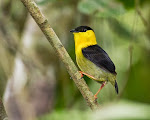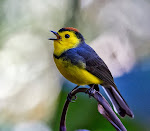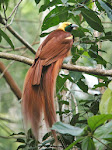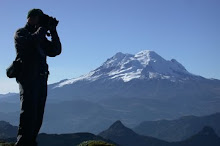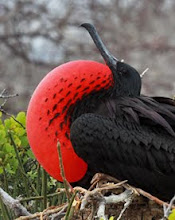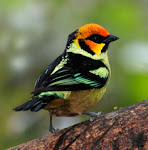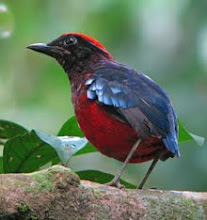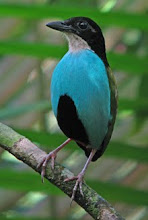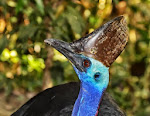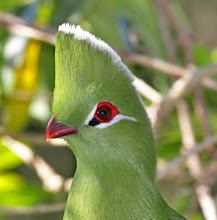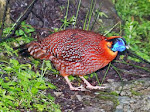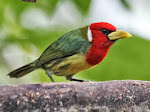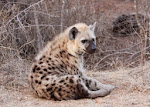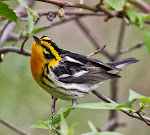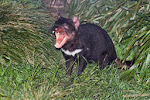Under a lit sky, I had arrived in
Alaska, sometimes known as the “Land of the Midnight Sun”, the night before.
These were my very first steps in the state. On this day I was to lift my
binoculars for the first time in Alaska, at which point I feel I can truly “count”
the state as visited! Also, in the middle of the un-darkened night, friends Iain
Campbell and Nick Athanas had also jetted in to start a tour of their own.
However, before, we divvied up into our groups, Nick, Iain and I scouted around
the wider Anchorage area. We started out with woodpeckers on our brains, at Eagle River Nature Center, supposedly
a hotspot for them. On checking in at the center and getting the lowdown, it
was clear we should be focusing on something bigger there, as a family of Black
Bears were being encountered regularly that morning and were showing not far
away. This was a no brainer for me, having seen but one Black Bear in my life
(at Yellowstone National Park in Montana), I was keen to see one properly;
moments later we were. Up high in the trees were a mother and two bear cubs.
Being high in the trees, the photography conditions were frustrating, as the
mother used leaves for a screen to good effect, and the cubs just slumbered
without a care in the world, turning them into nothing more than ill-defined,
furry shapes. However, suddenly, the adult bear was on its paws and making its
way down the trees. We rapidly backed away, knowing that to confront a mother
bear with cubs in the vicinity is not just folly, but potentially perilous. She
seemed unconcerned by our small group standing back, but what was alarming was
how impressively she would disappear in seemingly only sparse cover below; at
times only her ears gave her position away, but for longer periods not a piece of
fur was visible, and her exact location unknown. Her position on the ground
though did cause the cubs to stir too, who seemingly reluctantly, rather
gingerly, shinned their way down the large cottonwood trunk, which made for
great photo moments. The cubs and mother were soon reunited, and quickly melted
into the forest behind, where they were soon visible no more.
The woodpeckers were far from
cooperative, but my main target there was clearly to be Varied Thrush, a common
Alaskan native, but one I had never seen, with only limited time spent birding
in the western US. This thrush throws off the usual pigments of other American
thrushes, browns not being sufficient for this northern breeder, preferring a
mix of blue-gray and bunt orange. It was this reason that made me want to see
it with such gusto. What I had not realised would add to its considerable
allure, was its haunting song, a series of downward slurs that rang out of the
tall spruce trees at Eagle River. It was haunting, beautiful and evocative,
but, frankly, where was it!? I had been warned by Iain they like nothing better
than calling from the densest, highest canopies when possible, and the first
few heard were frustrating testament to that. However, moving into a stand of
smaller, younger spruces we tracked one down by following its haunting marker,
and it was everything it was cracked up to be (perhaps immortalised best by
Sibley’s famous Western Birds cover to his popular guides, which featured a
flying impression of this species).
After enjoying the views of Grey Jays and the jaw-dropping scenery, it was decided we check out a couple of
sites closer to Anchorage. Potter Marsh came first, with its abundance of
breeding Mew Gulls and Arctic Terns being very conspicuous there. However, we
also saw some singing Orange-crowned Warblers singing on a bright and sunny day
that felt somewhat like a European spring day, with cerulean skies and wisps of
clouds only, and an unexpected warmth in a state known for its proximity to the
Arctic. A few Lincoln’s Sparrows were in song too, as were several Alder
Flycatchers, but the prize bird that was probably a Short-billed Dowitcher,
which was happy to sleep in the open within inches of parked cars.
Our final stop of the day was a
popular Westchester Lagoon, which with the extraordinarily warm weather seemed
to have brought out every jogger, cyclist, skater and fitness enthusiast out of
the woodwork. We weaved our way through these active groups, at a somewhat
slower pace, as we admired gatherings of scaup, and mainly the dozens of
Red-necked Grebes congregated on the lake, Westchester’s star avian attraction.
A small group of Sandhill Cranes was also seen closeby, before we returned to
our Anchorage hotel to connect with our corresponding groups, and plot our
plans for moving into the Arctic Circle the next day, for a vastly different
experience indeed.





















